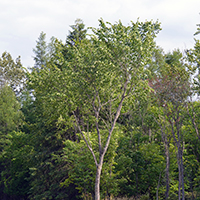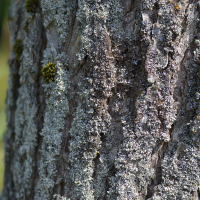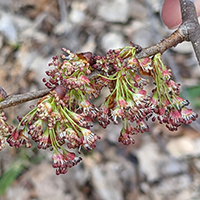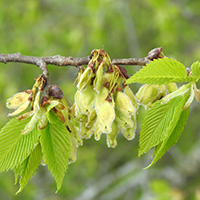What American elm looks like
Size and shape
- Large tree reaching 24 to 30 metres tall.
- Canopy has a round shape.
Leaves
- Dark green.
- Oval shaped.
- Grow in alternate, simple arrangement.
Bark
- Gray or brown in colour.
- Develops deep, diamond shaped furrows as the tree ages.
- Cross sections are wafer-like.
Flowers
- Small clusters of 3 to 15 green-yellow flowers.
Fruit
- Winged seeds that mature in spring.
Where American elm is found
American elm grows across Southern and Central Ontario, north to Timmins and west to Kenora. Most trees found in the wild are young and medium-aged trees. Dutch elm disease killed most older elm trees.
What you need to know to grow American elm
- Moisture: adaptable but grows best in moist sites.
- Shade: grows best in full sun but tolerates partial shade.
- Soil:grows best in rich, well-drained soils.
- Cautions: Many American elms have been killed by invasive Dutch elm disease. If planting an American elm, consider choosing a disease-resistant variety and plant with other species.
Benefits and uses of American elm
Wildlife benefits
American elm trees provide a food source and nesting habitat for several birds and small mammals. They are also host to butterflies, moths and other insects.
Commercial uses
The odourless wood from American elm can be used for:
- crates for cheese and produce
- veneer
- furniture
- pulp and paper
Fun facts about American elm
- Some isolated American elm trees in Ontario that have survived Dutch elm disease have trunks more than 4.5 metres in circumference.
- Before Dutch elm disease, American elm was one of Ontario’s largest native trees. The University of Guelph Arboretum identifies large survivors and is assembling a gene bank for breeding resistance.
- American elm grows well in both rural and urban habitats.
Updated: January 24, 2024
Published: July 18, 2014




